Entering The Boardroom with Cheryl Campbell and Jo Lynne Whiting
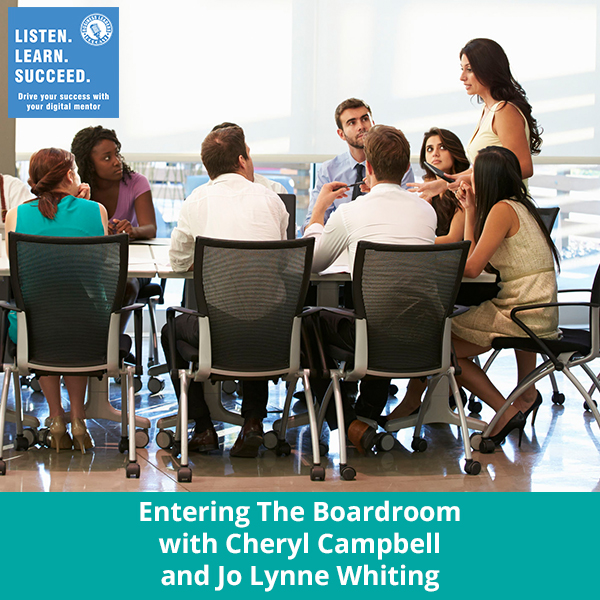
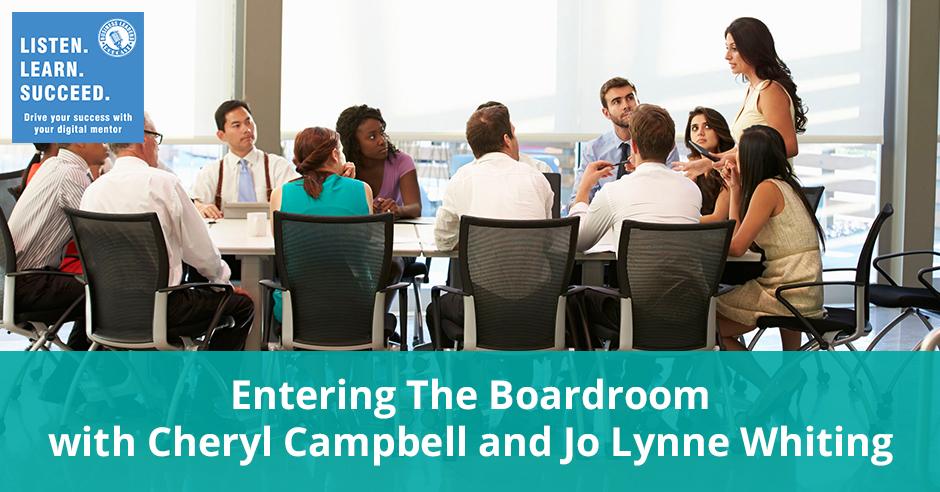
As the world continue to shift and improve, the spaces for women in leadership positions have greatly opened up. Cheryl Campbell, former Senior Vice President of Xcel Energy and the Independent Director of Hoffman Southwest, takes us to the boardroom as she engages her experiences as a woman functioning in board roles. Together with Jo Lynne Whiting of Board Bound, we follow Cheryl as she describes her responsibilities from working with Xcel Energy to Hoffman Southwest. She provides great insights and advices to those young men and women who would love a career path that would soon serve on boards, laying down some pointers on how you can make key decisions and add value – from compliance and progress to employee safety and acquisition. Cheryl then sheds a light for women who want to participate in nontraditional areas, encouraging them to have the confidence to pursue what they love to do.
—
Entering The Boardroom with Cheryl Campbell and Jo Lynne Whiting
We’re doing a cohosted version of the show. My cohost is Jo Lynne Whiting. She is a previous guest on the podcast. She is with Boardbound by the Women’s Leadership Foundation. Our guest is Cheryl Campbell. She is the former Senior Vice President of Xcel Energy, retired and she’s also the Independent Director of Hoffman Southwest. For the folks that don’t know what Hoffman Southwest is, they are the parent company of Roto-Rooter.
They do Roto-Rooter and Pro-Pipe. They do a lot of pipeline work for the utility industry.
Tell us a little bit about what you do, what you’ve done in the past. We’ll bring it forward to your service on boards and the relationship that you have with Boardbound.
I spent about 35 years in the energy industry, about twenty years with the old Coastal Corporation, Colorado Interstate Gas and the last several years was with Xcel Energy. I retired from there. I spent a lot of time doing engineering, strategic planning, operations, regulatory work and a wide variety of things. I was very fortunate to have many opportunities and do a lot of interesting work over the course of my career. I got interested in boards relatively early on. I sat on a number of nonprofit boards. I decided I wanted to serve on company boards. It’s been a great career. I’m really happy to be here and talk to you about what I’ve been up to in the Boardbound Program.
Cheryl, you were an executive in the energy business. We have a lot of energy businesses here in Colorado. For those people that may not be familiar with Xcel, could you describe the scope of your responsibility?
Xcel Energy is a combination gas and electric utility provider and they serve eight states. We had two million gas customers and about 3.4 million electric customers. It’s a good-sized company. Overall, I ran the gas business for Xcel. I was responsible for those two million gas customers, our employees and our asset base. I have spent the last several years or so building their asset management programs and their risk management programs. Working with our board to improve our risk management and our safety both for employees and the public around our system. It was a great opportunity. We made a lot of good progress while I was there and they continue to make a lot of good progress now.
For the young men and women that are out there and they’re going to go, “I’d love to have a career path where I progress and succeed and end up running a division and being able to serve on boards.” What advice would you offer to our audience that has an interest in heading and trying to replicate your success?
First of all, you’ve got to be good at what you do. You need to be good and competent at the work that you do. You need a broad skill set. You can’t focus on being an engineer or an accountant or a financial analyst. You need to broaden your capabilities, your skill set and your leadership. Some of the stuff that made a big difference for me was I never shied away from trying something new and different. A lot of times people would say, “Nobody wants to volunteer and do that,” and I’d say, “I’ll try it. I’ll do it.” Step up and try to do stuff that might be a little bit out of your comfort zone. When I decided that I wanted to get more involved in serving on boards, I started talking to a lot of people. You start thinking about whom I know that can tell me about this or has done it before. I started realizing I knew a lot of people that already sat on boards or interacted with boards. I started asking a lot of questions. One of the big things that came out was your leadership capabilities and the ability to think strategically. I started looking at getting more involved nationally. For instance, in the gas industry and taking on leadership roles at the national level with the trade associations and with the Department of Transportation that does a lot of the regulatory work. You need to investigate what skill set you need to do it. You need to look at ways that you can build that skill set on the career path that you’re on. That’s a broad overview.
Jo Lynne, your career was not that dissimilar because you progressed and then both of you have pursued higher education and more expertise in the formal education system. The thing that we’ll dive off into is for the folks that have a career and then go, “I’d like to serve on a board,” and they go short of a mentor somewhere. How in the world do I figure out what I need to do? Jo Lynne, that plays into Boardbound.
We were excited. Cheryl, you were part of the Corporate Boardbound program. Tell us about that year and the year before because you were involved over a period of their time.
I was and I initially got involved. I’d heard about the Boardbound program from a colleague and reached out and joined it. Unfortunately, the mentor that I had ended up having a serious health problem. I didn’t get to complete that first year. Jo Lynne and her colleague reached out to me and said, “Come back and we’ll pair you up with a different mentor,” which was John Kelley. I got to restart the program and do it again. It was helpful as far as that goes. It’s not going to teach you some of the things you learn by working in Corporate America and interacting with boards and other executive leaders. What it does do is help you understand how to frame your value that you can bring to a board, how to build a board resume. I had a board bio. How to go through the interview process and then how to get your name in the right places so that you might be considered for a board role.
We did some play interviewing. It was helpful because people are making suggestions and critiquing. You came across this way. Is that the way that you meant to come across? All of that was a helpful process. The other thing I liked about it was the program brought in relevant topics. One time we talked about cybersecurity and board governance. That’s a hot topic for boards. How should boards be thinking about cybersecurity and how it impacts their company and the future of their company? That helps you understand that broader strategic thinking that you need to be doing when you’re on a board as opposed to, “I own this business unit or I am focused on that particular aspect of the company.” It helps you look a little more broadly. That’s an important aspect of the program.
We’re proud of your cohort because there was great chemistry and we had seven people that are on boards that some of them are public boards. Some are private boards and some are advisory boards but they’re all corporate board positions.
If you go through the Corporate Board Bound Program, you have a clearer idea of what your value proposition is.
It was a great group of people. You get a chance to bond together and to share stories and to say, “This happened to me and I wasn’t sure how to respond to that.” You’re not only learning from your mentor, but you’re also learning from the other people that are participating in the program. It was a great experience.
Much of that is trying to find a mentor or finding a resource for information. Do you find that you reach out to your classmates?
We do sometimes. We’re all connected on LinkedIn, which is a great way to stay in touch with each other because nowadays, people just disperse. You might be together for a little while, but then you move to another part of the country or your role in a different part of the city even. It’s difficult to stay connected with people. We do communicate via LinkedIn on a regular basis and we could see what other people are up to. Jo Lynne has talked about getting up the alumni group back together, which would be a terrific thing to do to keep people connected over time. It’s been a helpful group. It was an interesting group. Everybody came at it with different backgrounds. I learned something from everybody in the program.
A lot of it is your own personal network. Tell the story about how you got on the Hoffman Southwest Board.
I went to a board meeting for the American Gas Association for my boss who was Xcel’s board member. He couldn’t make it so I went. I had dinner with one of the other board members and I’d known her for a while. She worked for National Grid, one of the other utilities in the country. We got to talking about women on boards and helping women learn how to take on senior executive roles in companies. Two things came out of that. One was the American Gas Association built a Next Level Women’s Leadership Development Program. It’s helping women understand the skills that they need to develop to take that next step in corporations. The second one was this woman called me a few years later and said, “Cheryl, are you still interested in serving on a board?” I said, “Yes, I am.” She said, “I’ve been talking to these guys and they’re looking for someone in the utility industry that would be interested in serving on the board.” We started talking and it’s a private equity company. It worked. I’ve been on the board for a while now and it’s been a fantastic learning experience. I like to think I’m adding some value to the board. I had no idea that this would end up coming out of that conversation after that trade association dinner over one last glass of wine basically is the way it all came together.
A lot of times people do get the positions of their own network. What we found is if you go through the Corporate Boardbound Program, you have a clearer idea of what your value proposition is. People can help you more if they know what role you can play. That was one thing that was great is you’ve got crisp on where your value was and how you could add value. Was that hard to think through?
It is hard to think through. It’s easy to say, “These are the things I’m good at.” You have to look at it from the point of view of what can you offer the company as board governance and from a board role. The boards don’t run the day-to-day company. That’s what you have leaders, managers and executives for. The board’s there to provide guidance and strategy and key decisions. How can you help them make those key decisions and add value? You do need to think about it from a little bit different point of view as opposed to here’s the value I bring a company and my day-to-day leadership capabilities to what can I offer a company from a governance role or from a strategic role? Those are different things. It did take a while to say, “What do I think I can add to a board?”
 Boardroom: Being in a program not only makes you learn from your mentor but also other people who are participating.
Boardroom: Being in a program not only makes you learn from your mentor but also other people who are participating.
When you first got involved with Boardbound, you were still working for Xcel. What’s your time commitment to go through Boardbound?
It wasn’t too bad. At first, it felt a little daunting with the pre-work and the different things that they gave us. As you got into it, it didn’t feel too bad. We met every two or three months. You had a little bit of homework to do and a book to read. I traveled enough. I found I had plenty of time on an airplane to do that work. Part of it is introspection. How do you think you can add value to a board, talking to other people? I did that. I admit it. I talked to some people that I know that I think highly of like, “I think I have value here. What do you think?” and got some feedback from them. You hear about strengths from some of these people that you didn’t think of necessarily as strength. That helped me coalesce around here’s the way I should phrase this to say how I can add value to a board. It did feel a little daunting at first because the job I had took a lot of time. It was a 60 to 80-hour a week job. It did feel a lot at first. Once I got past the first meeting or two, I found that it wasn’t that bad. It was easy enough for me to stay up with the class and to get a lot out of it. It’s like everything else. You get out of it what you put into it.
Thinking of the first board meeting that you went into after you got brought on this board. Take us to when you’re in at that board meeting. What were you thinking?
It’s fair to say I was nervous. I had met most of these people beforehand as either part of the interview process or having lunch with them. I knew almost all of them. Still, you’re nervous because you don’t necessarily understand the dynamic. You don’t know how their board governance and their structure works. I was pleased to be placed on the audit committee at first because that’s one of those prized committees on boards. You can learn a lot on an audit committee and you get a chance to see the goings on the financial side and the goings on at the company. I went into it very much, “I’m going to be an open mind and a sponge. I need to learn a lot.” I was nervous. You’re watching the dynamics and trying to understand the different roles different people are playing. It’s probably quiet for the first half of the board meeting and then try to make sure that I was contributing and asking questions and things of that nature. You don’t want to just be there. You need to contribute and to participate and engage. It was like your first day on a new job because it is a job. A board role is a job and you have to remember that it’s not a, “It’s cool,” and all that stuff.
We get pre-work, financial statements, information and the agenda. You need to go through that and spend some time before the board meetings. I had done that. I had reached out to the CFO and said, “Will you take me through this stuff beforehand?” He set up a web conference and we went through a lot of the stuff beforehand so that I knew what I was getting into. I wasn’t asking rudimentary questions in the board meeting. I’m not going to tell you that I immediately went in there and had my feet under me and felt comfortable because it’s not true. I’d say by the time we got to the second meeting, I was starting to get a little more comfortable with the process, how it works, what to expect and knowing people and how they communicate or don’t. Not everybody’s an effective communicator. Understand what some of the dynamics are and do a little bit better job engaging and participating in the meetings.
Are there any women besides you on that board?
People can help you more if they know what role you can play.
There are not. It’s a small board. I’m the only independent Director. The rest of the directors are members of the parent holding company. My perspective is that independent outside, a strong operations background and then connections into the utility industry that they’re looking and hoping to market their services to. I am the only woman. The company has a woman Chief HR officer. She’s usually in the room for the board meetings as well, but the rest of the participants are men.
The value adds when you come in the board. You’ve got the first board meeting. How many board meetings have you been at?
Four, the fifth one will be later.
When you think about day one, the first board meeting and you go in now, what’s your mindset difference between the two?
I’m not nervous anymore. I feel like I understand the numbers and the process better. The company has been through a lot. They weren’t hitting some of their targets and their numbers. We’ve had some challenging board meetings as we’ve talked through what some of those issues have been. We worked the plan a little bit. It’s been intense at times. It’s like a lot of other things when you’ve been through some more intense, things aren’t always rosy conversations. It helps you focus on what’s important and what the dynamics are.
Certainly, the financial side is critical but you can’t hit your financial targets without a lot of other things working correctly in a company. That’s true if you’re a public company or a private equity firm. We’ve had a lot of interesting conversations about the employees, their incentive programs, the culture and the way the employees are interacting with their frontline leaders. I feel a lot more comfortable now. I know a lot more about the company. I know the people a little bit further down in the company. I have a good idea of what their weaknesses and their strengths are. You’re trying to help them build on their strengths and how to make sure that weaknesses aren’t taking them down. It’s different now than it was before and I’m a lot more comfortable with the process.
You’re working for this company and strengths and weaknesses and progress and not progress in some of the areas. Do you have the bandwidth to be on another board?
 Boardroom: A good board can provide good direction and focus for a leadership team.
Boardroom: A good board can provide good direction and focus for a leadership team.
I think so. I’m retired. I’m doing a little consulting and I’m doing board work. That’s what I wanted to do when I was retired. My bandwidth is going to be how many do I want where my husband and I could still travel and do the things we want to do? I could easily do another board and maybe a third, and still work within the timeframe, the time commitment that I want. Boards probably take ten to twenty hours when you’re doing prep work for a meeting if you’re serious and you’re reading all the materials and staying engaged. If there are things going on, you might have meetings in between, the quarterly meetings as well. That has happened with my board on Hoffman Southwest. We’ve had a couple of meetings outside of board meetings or information that you get. Do we need the board to approve this deal or that deal? You need a little information before you can approve those deals. You can’t go, “I approve.” I can handle one or two more and still be able to do the things that I want to do.
In Colorado, overall we have of the public company boards we have 14% women. Our energy companies are less than 10%. Xcel did have a more diverse board. You interacted with Xcel board. Could you reflect on how that went? Did it make a difference that it was a more diverse board?
It did and the Xcel board is a great example of a good board having a positive impact on a company. I started interacting with them in 2010 after the San Bruno incident in California that happened to PG&E. A month later, I was standing before the Xcel board talking to them about Xcel’s gas assets and what we were doing about managing that risk. I’ve learned a lot from the Xcel board. It’s varied, about three or four women on the board. They’re all wonderful people, the men and the women. They’ve taught me a lot about governance and risk management. I spoke to them regularly about what we’re doing managing our risk. They ask good questions about culture and how you’re changing your culture, improving the culture and keeping the public safe. They’ve been a great sounding board. They know that I am interested in board service and have been extremely supportive. They’ve been a great resource as well.
They challenged the Xcel leaders before San Bruno even about safety where we had an unfortunate incident. They challenged us in the right way. They said, “You’re top quartile in these metrics. Why aren’t you top quartile in safety?” It made us all pause and stop and say, “We need to put some focus on that.” I’d say after that, we improved our safety metrics remarkably. We were in the fourth quartile for employee safety and we’re right on the edge of the first quartile when I left. The public safety metrics we track were the same way. We’ve made a significant improvement on the order of 30% to 50% improvement on our public safety metrics. Our environmental programs were improving dramatically. I’d say a good chunk of that came from the board asking the right questions in the right way of the executive leadership team. I’m not going to say it didn’t take a lot of hard work by a lot of people within the executive leadership team. A good board can provide good direction and focus for a leadership team.
You go, “We’re going to take and go from here to a 50% improvement.” You were also chatting about culture change. As you go through as a board and you go, “This is a direction,” and then the management team and executives execute the vision at some point. As a board, what did you do to look at either compliance or progress? How did that come to you to see if it was happening?
Some of the metrics are difficult. Employee safety is easy. It’s OSHA. Everybody goes to OSHA and what they call DART. Those are well-known metrics and they’re relatively straight forward to track. What we discovered over time with a lot of the other metrics were there weren’t any common industry metrics for improving public safety or some of the ESG stuff, the environmental goals. We ended up building a lot of this stuff as we went. I go in and I talked to the board and say, “Here’s how we’re looking at this aspect of it.” They challenge us, “Are you sure that’s the right metric? Have you thought about it from this point of view?” We’d go back and rework it. We’ve had some metrics evolving and changing over time. You have to be flexible. You have to hear what they’re saying and the questions they’re asking and then try to figure out how to build a metric that’s not going to take a lot of time for your employees to track and do something with. It’s going to give us a meaningful message that we’re making progress. Sometimes those are very difficult to figure out what those are.
We need to do a better job as a society and as schools in showing people how there’s a big breadth of things you can do.
We come up with some within Xcel that we thought were relevant for the work we were doing and the issues we were attacking. I’m confident that they will continue to evolve over time as you knock them down and get past those. We all know other things come up in culture. There’s a new one. I solved that cultural problem or that attitude. Now, I have to move to the next problem. I thought we laid a decent groundwork and we came up with some stuff that helped us say, “We’ve moved forward. We’ve improved this aspect of it,” but then something else will turn up and you’ll have to move to a different one to show the progress on the next one. You have to be flexible is what I’ve discovered. OSHA and DART are consistent, but a lot of this other stuff until companies gets focused on the same indicator like OSHA and DART. Those are lagging indicators and we all wish we could generate leading indicators that show the right things. I don’t think anybody’s found any awesome leading indicators for employee safety either. That’s why we all still use OSHA and DART. There aren’t many good leading indicators for that stuff.
You mentioned safety, but also environmental. That was an area where you had some improvements.
Xcel’s done a great job with their environmental work on the electric side, reducing greenhouse gas emissions. On the gas side, there wasn’t a lot of focus on it when I first started, but we knew we had to do something. Xcel is an environmental leader and you can’t have part of your business dabbling in that and being a leader and the other part not. We developed some of our own metrics and some of our own measurements internally. For instance, one of the things that we had made significant progress on was reducing methane emissions to the atmosphere when we do pipeline construction work or we have people who hit our pipelines. How we deal with that and how quickly we can get those off, reducing those methane emissions to the atmosphere. We measured that and could show that we had made significant progress over time.
I think about the perception of boards. You’ve got some of the employees that have no clue. Some of the employees that are beginning to get a clue and then there’s the senior leadership that’s fairly clued in. When you’re on the board and you’re looking top-down guides through the company, what do you think the key is to get the message from the board to the employee to affect behavior? What do you think that mechanism is?
Frontline leaders, those are the people that the majority of your employees interact with on a day-to-day basis or their supervisor or their manager. Touching those people and getting those people on board with your vision and engaged is critical. It might be anything from they don’t necessarily have the leadership skills or the management skills that they need to do it effectively. You need to help them, support them and help them learn and grow in those capabilities. Sometimes they don’t belong in that role. They might be good people and good employees, but not necessarily in that role. Can we put them someplace else in the organization so that they can contribute? They’re not necessarily contributing in that way with those frontline people. Some of it is one conversation at a time. We’ve all heard the adage about, “If you want people to remember, you have to say the same thing ten times a day for ten months before it sinks in.” Some of it is a lot of repetition, “This is our vision. This is our path. This is where we’re going.” Let’s be very consistent in what that message is.
In Hoffman Southwest, you did an acquisition while you’ve been on the board. The vision of the existing company and then behaviorally how you guys consider acquisition and then vision transmission to the acquisition. Let’s dig into that one.
I’d say we’re in the early stages to that last piece. Like most private equity firms, their goal all along was to buy more companies. They started with Hoffman Southwest as the core. Their intention has been to acquire additional companies to bring under that umbrella and expand those services. I’d say over the last year we’ve looked at a number of our acquisition targets or things that look like they were getting close and then for whatever reason it wouldn’t work. It’s been interesting at the board meetings to listen to people that were evaluating those acquisitions talk about them. “Here are the pros and cons and here’s where it would add value to our company. Here’s where we think there would be some challenges with that.” This last board meeting I was at it looked like we were getting close. We were going to be able to bring the deal together. Sure enough, it worked out.
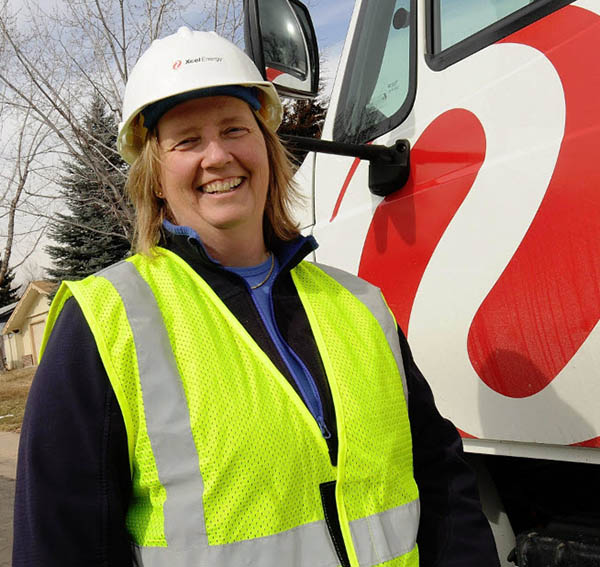 Boardroom: Just because you have an engineering degree doesn’t mean that you have on steel toe boots and walk around a processing plant. Engineers can do a lot of different things.
Boardroom: Just because you have an engineering degree doesn’t mean that you have on steel toe boots and walk around a processing plant. Engineers can do a lot of different things.
This will be our first board meeting with the bigger company. How that integration happens going forward is going to be a big topic for this next board meeting. How are you going to get everybody focused and aligned and all working together, pulling the same direction? I’ve been through a couple of mergers and acquisitions in my career. It’s challenging at the leadership level, frontline, mid-level and executive leadership to get everybody on the same page. I’m hopeful that my own personal experiences with acquisitions are going to help provide some guidance and some intelligence for the leadership team at Hoffman.
If it’s an acquisition-based organization, there will be additional acquisitions presumably. As you go through your lessons learned and you’re learning as you go and everybody’s bringing their past experience. Do you think that within the board environment they’ll start to get systematized on acquisition behavior?
It’s a distinct possibility. A lot of private equity companies are focused on acquisitions rates. They clearly have a model. The key things that they look at that they feel are important to the acquisition from a financial aspect and a market aspect. How well they think it will fit. The stuff that’s a little harder or the soft things with the employees and the merging cultures and things like that. We’ve all seen big acquisitions and mergers fail. We could probably name a few of them. Chrysler comes to mind where they never got the cultures together. GE comes to mind. It’s clear to me that they’ve got a good systematic way of evaluating it. It will be interesting to see what about that softer stuff and how does that fit with the overall model. I have to say they’ve been doing it for a long time. It’s not like this is a new thing for them. It’s new to me, but it’s not new for them.
One of the things I was looking at it is you have a chemical engineering degree and then you have a business degree. We have not made a lot of progress in getting women into STEM, the Scientific, Technical, Engineering and Mathematical. First of all, what inspired you to pursue that? How do you think we can be sure that there are more women participating in some of these nontraditional areas?
I’m going to say that I got interested in it because I was good at math and science in high school. This was pre-internet and web and all this stuff where you could google it up and do a lot of searches. I had a high school counselor say, “You should look at engineering.” I applied to the engineering college and got accepted. I ended up in chemical because the dean basically said, “Those of you that are undetermined, better come down here and pick one or you’re going to do them all.” There’s a threat and I’m a dumb eighteen-year-old first gen college kid that didn’t know any better. He scared me. I walked down there and I went, “I liked chemistry in high school,” so I signed up for chemical engineering. It was that straightforward. After the first semester, I went, “This is interesting. I like it.” It worked out for me but I didn’t have a grand plan or anything like that.
How do we get more women and diverse groups into them? It’s a tough nut to crack. I sat on the advisory committee at CU Boulder for a while and that’s building opportunity through leadership development. They work with a lot of first gen and underrepresented groups in the engineering school and the STEM schools. One of the things that stuck in my mind from that was people have a hard time envisioning themselves in that role. It’s easy to say, “We need to show them more role models.” You also have to be willing to show them the things they can do and the things they can be.
What a lot of women don’t realize are men have the same self-confidence issues, but they do a much better job of hiding it.
Just because you have an engineering degree doesn’t mean that you have on steel toe boots and walk around a processing plant, as an example. You don’t necessarily wander around a highway project where they’re building bridges and stuff. Engineers can do a lot of different things. There are roles for construction engineers. There are roles for planners. There are roles in leadership for technical backgrounds. We need to do a better job as a society and as schools of showing people that there’s a big breadth of things you can do. Biomedical field, space sciences and the impact this can have on society. If we can do a better job at doing that, we’ll be able to retain more people in the STEM fields. They can see a path for themselves. It will make a difference.
I think about the access to information and role models. For me, I was a pre-med kid and then I went to the Army. I have a biology, math, chemistry background and you go, “That doesn’t translate to the Army well.” The problem solving, being organized I’ve been able to take and go through it and conceptualize the problem. Figure out a methodology of getting from A to B, if then type work. For you, part of the reason we’re doing the podcast and part of the reason we’re doing these episodes is to talk about women that are functioning in board roles. What were the key differentials that brought you from wherever you were up to an organization to get you qualified to get to the point where you can serve and add value to a board? It doesn’t make you different than men. What’s the process so folks can visualize? My premise behind doing this and Jo Lynne and I have talked about it and you’re the first one to come onboard. Thank you for being the first one. With that being said, how do you take and help these kids get a visualization of what they can do? If that’s the challenge, what do you think the solution might be?
That is the hard part. How do we show them what could be? I spend time mentoring and working with people early in their careers. I am part of the Colorado Oil & Gas Association engine program. I speak regularly with that group. I’ve done work with the University of Colorado. I’ve done work with the American Gas Association, Southern Gas Association. I talk a lot about not only leadership but, “Look at all of these great things that are going on that you can do.” Frankly, we need to get a little lower in the educational system. I’ve seen studies in elementary school, young boys and girls are equal in their math and science. Somewhere in middle school, our young women decide that they can’t do it. Yet, they were showing they could do it before and they were as smart, as quick and as able to learn the concepts. There’s something about those middle school years that I don’t know if it’s because they figure, “The boys won’t like me if I’m smart,” or what the issue is. Somewhere in those middle school years is where we tend to lose a lot of our young women. They start believing that they can’t do math. They start believing that they can’t do science, they’re not smart enough. We’ve got to figure out how to overcome that.
In your own story, when that counselor said to you that you would be good at this, it made a difference. That reinforcement you are good at this, if we could get that message to a lot of girls and women as they’re coming up.
I’ll add to that. A big problem that women have is self-confidence. They have a hard time stepping into things. Different people have called it different things, stepping in, leaning in, call it whatever you want. The reality is what a lot of women don’t realize are men have the same self-confidence issues, but they do a much better job of hiding it and they do step into things much more so than women do. For some women, you figure that out earlier. Some women get all the way through their careers and never figured out that you can do it. You just need to try and put in the time.
A lot of women feel they have to be 100% prepared before they try. A lot of guys feel like, “I got this. I got 60%. That’s good.” Part of it is realizing that you don’t have to be perfectly prepared because a lot of your growth is going to come from doing it.
When I talk to women in some of these programs, I talk about that is you think that you have to have every qualification on that job description. You don’t. The men that are applying do not. You’ve got to figure out, have the courage to go ahead and throw your name into the ring and sell yourself. That’s a skill set that women have got to continue to develop.
When did your confidence come on board for you?
If you think that I’m 100% confident all the time, you’re wrong.
There’s a tipping point where you come and go. I can point to an event or a timeframe or a circumstance. I’m not good at everything, but I’m good at that. If I make up my mind to be good at that, I can therefore be good at other things. Did you have one of those?
I was very fortunate relatively early in my career to work for some good leaders and to interact with some good leaders. A couple of people took me under their wings without me even realizing it. When you have a vice president to stop into your office regularly and ask how things are going, it took me a few years before I realized what he was doing. He saw something in me that he thought he could nurture and grow and I was appreciative that he was willing to spend the time to do that. Somewhere in there, it dawned on me that there’s some stuff I’m good at. I always felt I had to work hard and put in a lot of time and I did. I spent a lot of time, nights and weekends to feel I had the confidence to step into some of those early roles. As you learn and grow in your career, you can move on from some of that stuff and worry about the next thing.
I’d say somewhere in my early 30s, it dawned on me that you can be a good leader. You can be a good technical leader because technical leaders get a bad rap. Most people that are strong on the technical side aren’t necessarily strong on the leadership side. It’s a different skill set. You have to work at it. I’ve worked at it over the years and realized that I have some of those strong engineering tendencies. I’ve learned to recognize what those triggers are that sent me down this path and push myself back into a better leadership role. People need to realize that it takes work. People make it look easy. I’ve heard people say, “Surely, they make it look easy.” There’s a lot of work that goes into it.
It’s like public speakers that are good and they go, “They’re a natural public speaker.” They have no idea.
Leadership is about setting a vision and then leading people down that vision.
They have no idea the amount of work that people are putting in behind the scenes to make it look like that.
I have a son and a daughter. The son’s hardheaded and does what he does. My daughter, she got involved with martial arts early on and it’s an extraordinary confidence builder. She’s going like you to the leadership program here in Denver as well, which is another building block. If you were to offer advice to some of these young men and women they’re going like, “I’d love to have more technical skills,” or “I’d love to have more leadership skills.” Are there resources or books that you read that you think would be helpful for them to try to identify, hone or improve where they are?
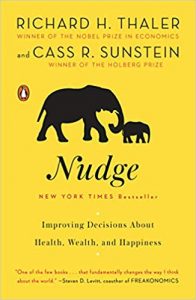 Nudge: Improving Decisions About Health, Wealth, and Happiness
Nudge: Improving Decisions About Health, Wealth, and Happiness
Everybody’s got different things they’re interested in. Some of my favorite books are Nice Girls Don’t Get The Corner Office is a great book for women because it attacks some of the self-talk that we all tend to have a going on in our heads all the time. It compares it to the way other people approach the same situations and helps you understand that you need to defeat some of that self-talk and get to a different place. Nudge by Richard Thaler is a good book. It’s about change and how you get people to change from where they are. Leadership is about setting a vision and then leading people down that vision. That means you have to convince people to change and to do something different. I enjoy his approach to trying to change the dynamic and get people to think a little bit differently and follow your vision. Adam Grant is a speaker and an author that I’ve enjoyed very much. He’s written a couple. I thought Give and Take was good and his whole premise is there are givers and takers in the world. The people that do well over time are the givers. He talks about the differences between the givers and the takers. I’m a voracious reader but those are three of the books that I remember and have had a big impact on me over time.
Cheryl, what I’m impressed with is how great it is to know you. It’s obvious that your senior leadership and your executive role is why you were successful. I’m glad that you’ve been embraced this goal of getting on boards because I know you’ll add a lot of value there. We need more and more Cheryls.
Thank you, Jo Lynne. I’m having a good time. This has been interesting so far and I’m enjoying the board work and the consulting work. I’ve enjoyed all of my careers. It’s been a great career overall.
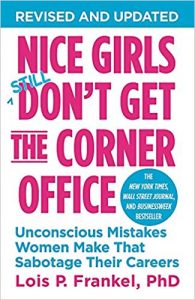 Nice Girls Don’t Get the Corner Office: Unconscious Mistakes Women Make That Sabotage Their Careers (A NICE GIRLS Book)
Nice Girls Don’t Get the Corner Office: Unconscious Mistakes Women Make That Sabotage Their Careers (A NICE GIRLS Book)
The stages of life, the stages are get your technical skills, get employed and then excel in what you’re doing and progress as far as you can. The phase into retirement, retirement means different things to many people. I’m not a huge fan, personally. The board work, the mental stimulation, the consulting work, it makes people live longer.
We all need a purpose.
The idea of sitting down is not an idea of what I’d want to do.
It’s a shame to lose that wisdom and expertise.
The podcast, part of the reason I do it is to explore and record the wisdom that you’ve paid so much tuition for. As we get further in our careers, you go, “I wish I could transmit shortcuts on this for some of the folks.” For you on the board, that’s a great way. The work with Boardbound is a great way to do it.
You were on community boards, nonprofit boards. You were on industry association boards. We have a Community Boardbound Track as well as the Corporate Boardbound Track. Did you think that helps? Was that part of your leadership development? What are your reflections upon those roles?
I’ve heard a lot of people say it’s different and you can’t transfer one from the other. I got involved with nonprofit boards early in my career. It started with Junior Achievement of Southern Colorado. I tend to think that they’re great for helping you understand governance and strategic planning. It’s different because a nonprofit has a different mission and objective than a corporation, but the governance issues and some of the strategic planning issues are similar. I had a chance to be involved early on in changing the path for Junior Achievement of Southern Colorado. You don’t get that opportunity often. It helped me think a little better in my day job about planning and thinking longer term and more broadly about where the company was going, how my department fit into that vision. If people embrace it that way instead of, “This is how a nonprofit works,” versus “This how a corporation works,” it can make a difference and they are transferrable skills.
That’s something you did early in your career.
There are givers and takers in the world. The people that do well over time are the givers.
I did and I would encourage people to do it. It’s a great way to give back. It’s also a great way to network and to learn about some of the things that we’ve been talking about.
Cheryl, Jo Lynne, thank you so much for taking time out of your day to come on the episode here. I look forward to doing more of these.
Thank you.
Thanks for having me.
Any parting thoughts or recommendations?
For women and men, lean in and take a chance on things. Step into things and try things outside of your comfort zone and you’d be surprised what happens.
Thank you.
Thank you.
Links Mentioned:
- Jo Lynne Whiting – Previous episode
- Boardbound
- Xcel Energy
- Hoffman Southwest
- Roto-Rooter
- Pro-Pipe
- Nice Girls Don’t Get The Corner Office
- Nudge
- Give and Take
About Cheryl Campbell

Senior executive in energy/utilities with experience in risk management, change management, strategic planning, ESG, regulatory policy and operational excellence.
My focus on operating excellence and delivering results benefits customers, communities and employees. I have a proven track record of improving performance and financial results, developing strong teams, and championing ESG as well as public and employee safety.
About Jo Lynne Whiting

Jo Lynne helps market leaders and competitive upstarts across several continents achieve marked turnarounds in 12 to 18 months. She has executive experience as an officer of a Fortune 100 company.
Jo Lynne has expertise in strategy, marketing, sales and operations. She combines analytical insight with pragmatic action to grow usage, revenue and profits. Focusing in telecommunications and advertising, she has grown share for companies she works with time and again.
She has consulted in the United States, Europe, Singapore and Australia with a range of work from new product development to field operations, aligning cross-functional workforce around customer needs to achieve industry-leading results.
Before consulting, she was part of executive teams at Sensis and Dex who led the world in industry revenue growth, usage and profitability. She was responsible for marketing, online product development and National sales.
She was an officer of US WEST (now Century Link) as VP–Local Markets for broadband and mobile networks as well as VP-Strategy for Local Search Advertising.
Her Board experience includes being President of a private venture (Texoma Home Health) where she helped found the startup, establish 5 year track record and then successfully negotiated the sale of the company. Her civic leadership focuses on environmental and women’s issues.
Love the show? Subscribe, rate, review, and share!
Join the Business Leaders Podcast Community today:
- businessleaderspodcast.com
- Business Leaders Facebook
- Business Leaders Twitter
- Business Leader LinkedIn
- Business Leaders YouTube
The post Entering The Boardroom with Cheryl Campbell and Jo Lynne Whiting appeared first on My podcast website.